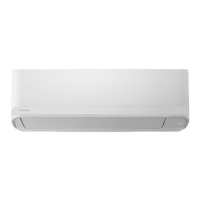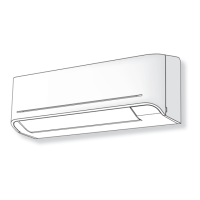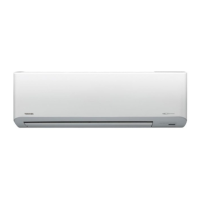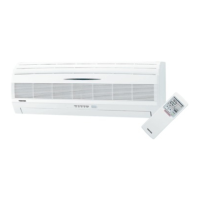
Do you have a question about the Toshiba RAS-24E2KVG-E and is the answer not in the manual?
| Brand | Toshiba |
|---|---|
| Model | RAS-24E2KVG-E |
| Category | Air Conditioner |
| Language | English |
Explains hazard symbols and their meanings on the unit.
Critical safety warnings; failure to comply may lead to severe injury or death.
Important safety warnings; failure to comply may lead to injury.
Specific safety precautions to avoid electric shock or unit damage.
Details on ECO, Wi-Fi, Hi POWER, Timer, and Operation mode indicators.
Instructions for removing and attaching air filters.
Steps for loading batteries into the remote control.
Guide for setting the clock and resetting the remote control.
How to adjust the louver for desired vertical airflow direction.
Note on manually adjusting horizontal airflow direction.
Explanation of functions for each button on the remote control.
Details on Silent 1 and Silent 2 modes for reduced noise.
How to automatically select cooling, heating, or fan only operation.
Steps to select Cool, Heat, or Fan Only modes and adjust settings.
Using the Dry mode for dehumidification with moderate cooling.
For faster cooling or heating operation using the Hi POWER button.
Utilizing the ECO button to automatically save energy.
How to activate 8°C heating and adjust the temperature.
How to start/stop the unit using the RESET button without the remote.
Instructions for setting ON, OFF, and daily timers.
How to decrease or turn off the display lamp brightness.
How to save and recall preferred operation settings.
How to enable or disable the auto restart function after power failure.
Activating super low fan speed for quiet operation.
Automatically controls airflow and turns off the unit after a set time.
Guidance on cleaning the indoor unit, remote control, and air filters.
Procedure to reduce moisture and prevent bad smells in Cool/Dry modes.
How to manually defrost the outdoor unit's heat exchanger.
Details on three-minute protection, preheating, warm air control, and defrosting.
Table showing operating conditions for Heating, Cooling, and Dry modes.
Common reasons why the unit may not operate.
Troubleshooting for abnormally low cooling or heating performance.
Procedure to set remote control for multiple indoor units (A or B).











